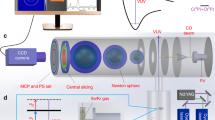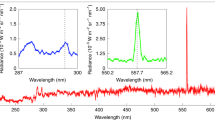Abstract
WE have made exact intensity measurements of the A group of the absorption bands of oxygen at λ7600 A. with the aid of the ‘raster’ method of Frerichs,1 using a 6.4 metre concave grating, infra-red sensitive plates, and three different lengths of light path, respectively 14, 33, and 60 metres. It was found that the exponential absorption law J = J0e−kd holds for these absorption lines; for the 33 metre light path, assuming that the peaks of our photograms can be identified with the true absorption co-efficient, we find for the strongest line an absorption J0 − J/J0 of 27 per cent.
This is a preview of subscription content, access via your institution
Access options
Subscribe to this journal
Receive 51 print issues and online access
$199.00 per year
only $3.90 per issue
Buy this article
- Purchase on Springer Link
- Instant access to full article PDF
Prices may be subject to local taxes which are calculated during checkout
Similar content being viewed by others
References
R. Frerichs, Zeits. f. Phys., 31, 305; 1925.
R. M. Badger u. R. Mecke, Zeits. f. Phys., 60, 59; 1930.
Author information
Authors and Affiliations
Rights and permissions
About this article
Cite this article
CHILDS, W., MECKE, R. Intensities in the Atmospheric Oxygen (Intercombination) Bands. Nature 125, 599–600 (1930). https://doi.org/10.1038/125599c0
Issue Date:
DOI: https://doi.org/10.1038/125599c0
Comments
By submitting a comment you agree to abide by our Terms and Community Guidelines. If you find something abusive or that does not comply with our terms or guidelines please flag it as inappropriate.



